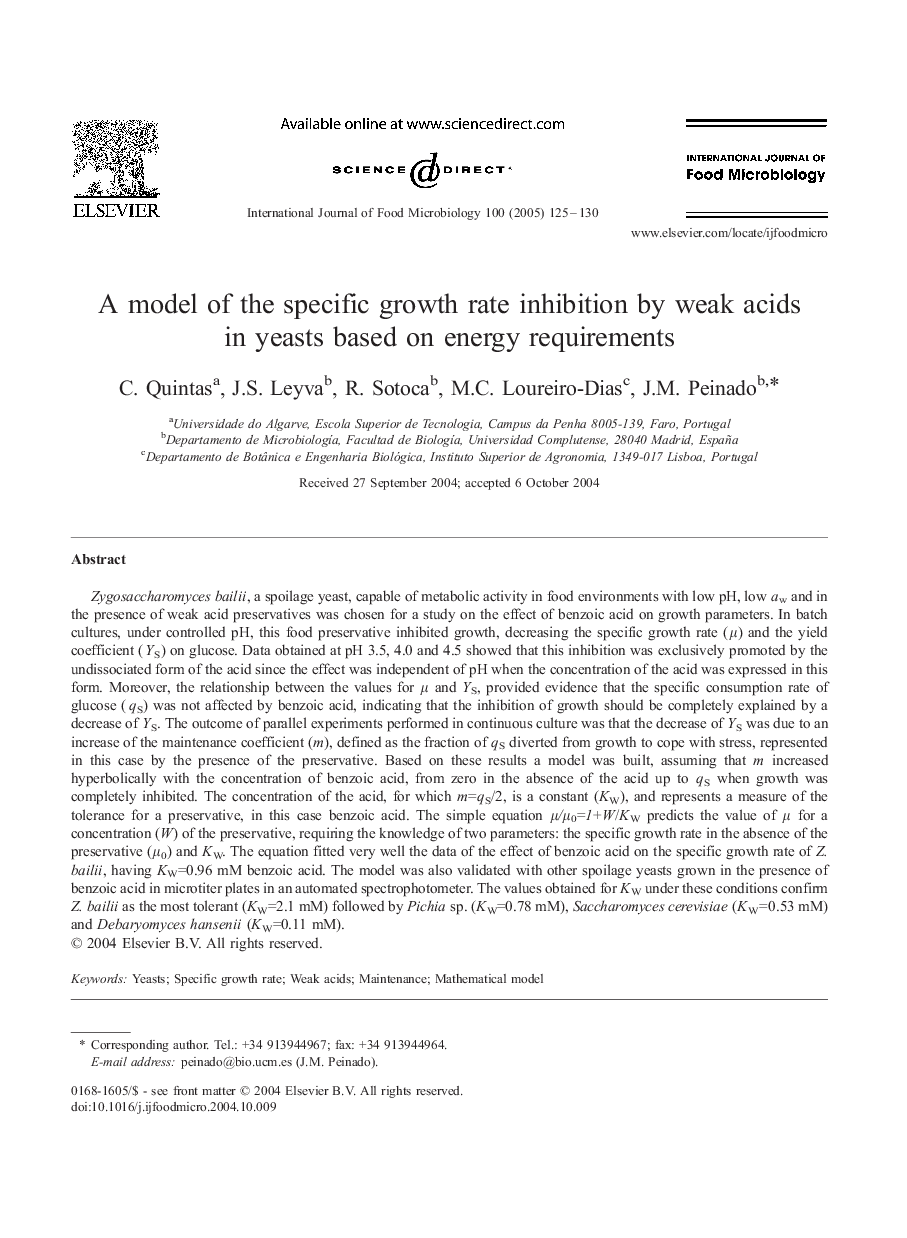| کد مقاله | کد نشریه | سال انتشار | مقاله انگلیسی | نسخه تمام متن |
|---|---|---|---|---|
| 10107536 | 1616793 | 2005 | 6 صفحه PDF | دانلود رایگان |
عنوان انگلیسی مقاله ISI
A model of the specific growth rate inhibition by weak acids in yeasts based on energy requirements
دانلود مقاله + سفارش ترجمه
دانلود مقاله ISI انگلیسی
رایگان برای ایرانیان
کلمات کلیدی
موضوعات مرتبط
علوم زیستی و بیوفناوری
علوم کشاورزی و بیولوژیک
دانش تغذیه
پیش نمایش صفحه اول مقاله

چکیده انگلیسی
Zygosaccharomyces bailii, a spoilage yeast, capable of metabolic activity in food environments with low pH, low aw and in the presence of weak acid preservatives was chosen for a study on the effect of benzoic acid on growth parameters. In batch cultures, under controlled pH, this food preservative inhibited growth, decreasing the specific growth rate (μ) and the yield coefficient (YS) on glucose. Data obtained at pH 3.5, 4.0 and 4.5 showed that this inhibition was exclusively promoted by the undissociated form of the acid since the effect was independent of pH when the concentration of the acid was expressed in this form. Moreover, the relationship between the values for μ and YS, provided evidence that the specific consumption rate of glucose (qS) was not affected by benzoic acid, indicating that the inhibition of growth should be completely explained by a decrease of YS. The outcome of parallel experiments performed in continuous culture was that the decrease of YS was due to an increase of the maintenance coefficient (m), defined as the fraction of qS diverted from growth to cope with stress, represented in this case by the presence of the preservative. Based on these results a model was built, assuming that m increased hyperbolically with the concentration of benzoic acid, from zero in the absence of the acid up to qS when growth was completely inhibited. The concentration of the acid, for which m=qS/2, is a constant (KW), and represents a measure of the tolerance for a preservative, in this case benzoic acid. The simple equation μ/μ0=1+W/KW predicts the value of μ for a concentration (W) of the preservative, requiring the knowledge of two parameters: the specific growth rate in the absence of the preservative (μ0) and KW. The equation fitted very well the data of the effect of benzoic acid on the specific growth rate of Z. bailii, having KW=0.96 mM benzoic acid. The model was also validated with other spoilage yeasts grown in the presence of benzoic acid in microtiter plates in an automated spectrophotometer. The values obtained for KW under these conditions confirm Z. bailii as the most tolerant (KW=2.1 mM) followed by Pichia sp. (KW=0.78 mM), Saccharomyces cerevisiae (KW=0.53 mM) and Debaryomyces hansenii (KW=0.11 mM).
ناشر
Database: Elsevier - ScienceDirect (ساینس دایرکت)
Journal: International Journal of Food Microbiology - Volume 100, Issues 1â3, 15 April 2005, Pages 125-130
Journal: International Journal of Food Microbiology - Volume 100, Issues 1â3, 15 April 2005, Pages 125-130
نویسندگان
C. Quintas, J.S. Leyva, R. Sotoca, M.C. Loureiro-Dias, J.M. Peinado,